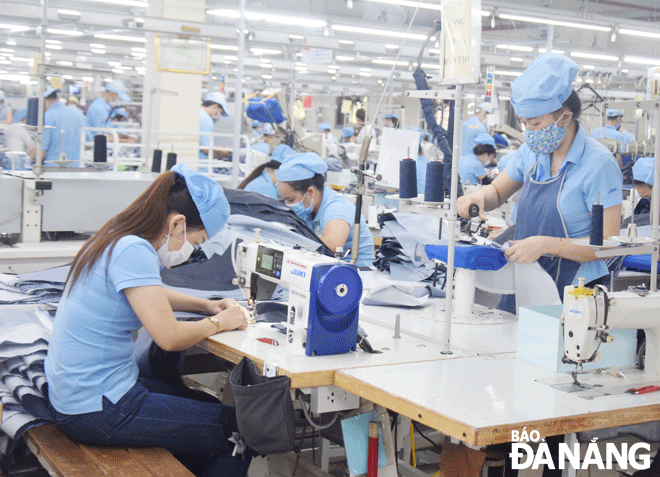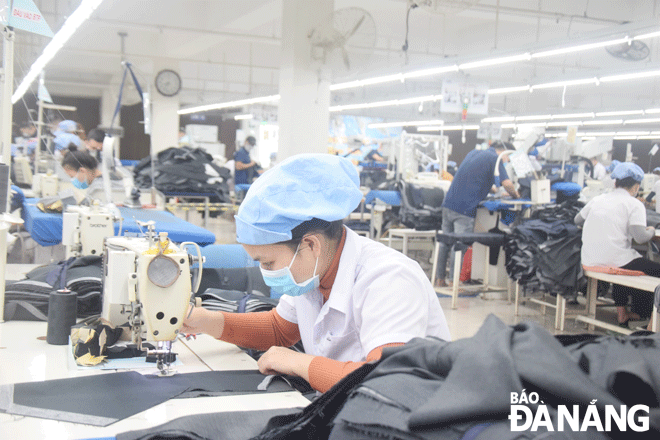Da Nang textile and garment industry towards green production
Going green increasingly becomes an inevitable trend among firms in the textile and garment industry, which will help reduce their dependence on natural resources, as well as minimize the negative impacts of their production processes on the environment.
 |
| Workers at the Hoa Tho Textile and Garment JSC. Photo: Q.T |
Inevitable trend
Currently, Da Nang has 9 enterprises engaged in the production of textiles, fabrics and yarns. This industry group makes up a relatively low proportion in the supporting industry, but there are large-scale enterprises such as the Hoa Tho Textile and Garment JSC, the March 29 Textile JSC, and the Hoa Khanh Textile Co., Ltd., plus and a number of prominent foreign-invested ones like the Advance Nonwoven Vietnam Co., Ltd based in the Hoa Cam Industrial Park specializing in the production of nonwovens, and the Kane-m Da Nang Co., Ltd. specializing in clothing accessories and handbags.
According to a recent survey, the majority of enterprises in the textile and garment industry in the city have been asked to "go green in production activities" in order to implement their social and environmental responsibilities and reduce emissions.
Therefore, many of them have focused on installing rooftop solar power systems and water and electricity reuse systems; replacing coal-fired boilers in dyeing plants with other biomass materials such as rice husks to reduce emissions and improve efficiency; and applying software to measure environmental impacts in manufacturing plants right from the sample development stage to be able to assess how materials and technologies affect the environment. From there, they have taken initiative to make plans to use materials and technologies that have less impact on the environment.
Mr. Nguyen Chi Truc, Director of the city branch of the Vinatex International JSC, said that his company’s partners and customers have increasingly high requirements for dyeing chemicals which have to ensure the health of workers, and have clear origin and the ability to handle chemicals after dyeing.
He remarked his company has invested and installed a system to recover caustic soda (Caustic Soda) - a wastewater treatment chemical capable of purifying domestic water and water in factories before being discharged into the environment.
In addition, the company plans to upgrade the 18-ton coal-fired boiler with Biomass which are derived from agricultural and forestry waste in a bid to reduce CO2 emissions. This machine will be officially put into operation in June.
According to the Hoa Tho Textile and Garment Corporation, textile firms use a large amount of electricity, so investing in rooftop solar power system at factories is one of the solutions towards the formation of green factories.
He added although the initial investment cost is large, the depreciation is fast. In particular, it takes textile factories in Central Viet Nam about 5 years to fully depreciate the initial investment cost. In the Southern region, the depreciation time is even faster.
Currently, the Hoa Tho Textile and Garment Corporation has invested in solar power systems in 3 garment factories with 100% equipment imported from Germany, meeting about 15-20% of the total power demand of the factory every month. Solar power can reduce the risk of power shortage during peak months and make the plants greener. Going green textile and garment factories is an inevitable trend if they want to retain customers as well as employees.
 |
| Production activities at the March 29 Textile and Garment JSC. Photo: Q. TRANG |
Great benefits to businesses
In early April 2022, the European Commission (EC) proposed applying some new ecological regulations for textiles and garments consumed in the EU. Specifically, this regulation requires apparel in the EU to be durable, reusable and repairable. To achieve this standard, manufacturers must use recycled, non-toxic, environment-friendly fibers. When textiles are no longer usable, manufacturers are responsible for recovery and recycling, with the least incineration and landfill of those products. All of the above information must be provided to consumers by manufacturers through a digital passport for each product.
According to Mr. Huynh Van Chinh, Chairman of the Board of Directors of the March 29 Textile and Garment JSC, in order to be consistent with the goal of sustainable and green development, the company has come up with a long-term plan until 2025 with a focus on investing in infrastructure and facilities meeting all standards of green and environmental standards in order to be recognized as a green factory.
“The company continues to maintain and improve the effectiveness and efficiency of management according to ISO 900-2015 standards and WRAP social responsibility, as well as to ensure standards in the supply chain of products and other quality standards of customers", Mr. Chinh added.
Mr. Nguyen Duc Tri, Vice Chairman of the Viet Nam Textile and Garment Association cum Chairman of the Board of Directors of the Hoa Tho Textile and Garment Corporation, revealed that the standards and assessment of sustainable development of enterprises are increasingly higher based on the level of compliance of enterprises with responsibility for workers, the environment, society and global consumers before products are put on the market.
New-generation free trade agreements (FTAs) signed by Viet Nam have rules and commitments on environmental protection and low emissions. This requires businesses to invest in production technology and automation, build a safe working environment for employees, and increase competitiveness for customers and consumers.
Mr. Tri underlined a must-do for textile and garment firms to renew modern equipment, be self-sufficient in the supply of raw materials and accessories and diversify consumption markets in order to improve competitiveness.
He suggested the municipal government issue more specific support mechanism, encourage the development of supporting industries, and develop a financial fund for the environment so that green businesses can access the fund and have a favourable financial source in order to speed up the investment process and improve their competitiveness in the international market.
Reporting by Q.TRANG - Translating by M.DUNG